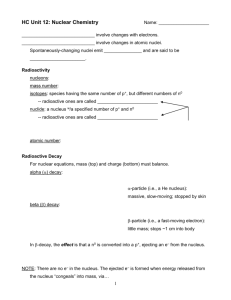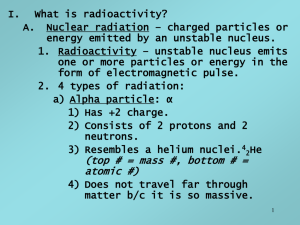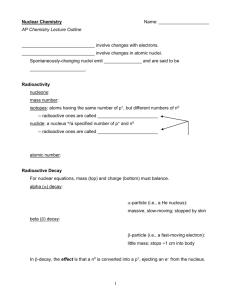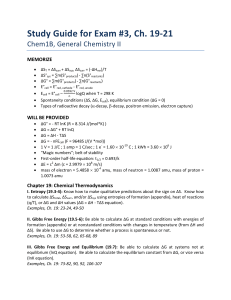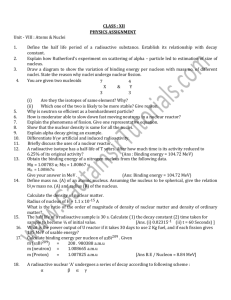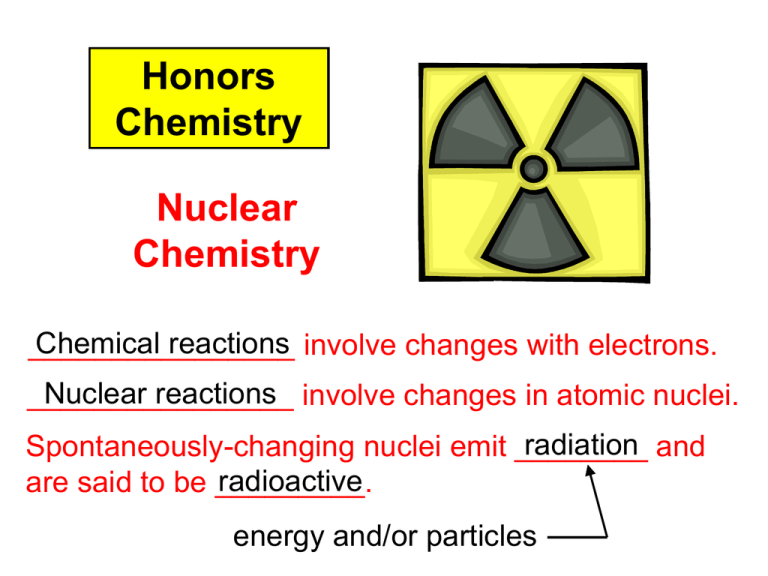
Honors
Chemistry
Nuclear
Chemistry
Chemical reactions involve changes with electrons.
________________
Nuclear reactions involve changes in atomic nuclei.
________________
radiation and
Spontaneously-changing nuclei emit ________
radioactive
are said to be _________.
energy and/or particles
Radioactivity
nucleons: protons (p+) and neutrons (n0)
mass number: (p+ + n0) in a given atom
isotopes: species having the same number
of p+, but different numbers of n0
radioisotopes
-- radioactive ones are called ___________
nuclide: a nucleus w/a specified
number of p+ and n0
radionuclides
-- radioactive ones are called ___________
atomic number: (Z); # of
p+
these are unstable
and emit radiation
Radioactive Decay
For nuclear equations, mass (top) and charge (bottom)
must balance.
alpha (a) decay:
234
92 U
230
4
90 Th + 2 He
(go DOWN
two #s on Table)
a-particle (i.e., a He nucleus):
massive, slow-moving;
stopped by skin
234
91 Pa
beta (b) decay:
234
0
92 U + –1 e
(go UP
one # on Table)
b-particle (i.e., a fast-moving
electron): little mass; stops
~1 cm into body
In b-decay, the effect is that a n0 is converted
into a p+, ejecting an e– from the nucleus.
1
0n
0
1
–1 e + 1 p
NOTE: There are no e– in the nucleus. The ejected e–
is formed when energy released from the
E = mc2
nucleus “congeals” into mass, via _______.
gamma radiation: consists of high-energy photons
-- can penetrate to internal organs
-- gamma ray: 0 g (or just g)
0
emitted when nucleons
rearrange into a more
stable configuration
-- The shell model says that nucleons
reside in shells, similar to… how e– reside in shells.
-- gamma radiation often accompanies
other nuclear decays
234
92 U
230
4
0
90 Th + 2 He + 2 0 g
positron decay: 23 Mg
12
23
0
0
11 Na + 1 e + 0 n
positron: identical to an e–, but (+)
neutrino: “massless,” chargeless particle
electron capture: nucleus captures orbiting e–
11
0
6 C + –1 e
11
0
5B + 0n
The effect of positron decay and electron capture
is to turn a p+ into a n0.
1
1p
0
1
1e + 0n
POSITRON DECAY
1
0
1 p + –1 e
1
0n
ELECTRON CAPTURE
Nuclear Stability
strong force
Nucleons are held together by the __________.
~1.5 n0 : 1 p+
Band (or Belt)
of Stability
# of n0
~1 n0 : 1 p+
0
Z (i.e., # of p+) 83 At Z > 83, none are stable
(i.e., all are radioactive).
Nuclei that…
…have too many…
…and stabilize by…
…are above belt…
n0
…are below belt…
p+
b-emission
positron emission
(or e– capture)
…have Z > 83…
p+ and n0
a-emission
Examples:
(a)
242
94 Pu
4
238
2 a + 92 U
(b)
163
64 Gd
0
163
–1 b + 65 Tb
145
65 Tb
0
145
1 e + 64 Gd
(positron emission
or e– capture)
145
0
65 Tb + –1 e
145
64 Gd
A radioactive series is the decay sequence a
radionuclide goes through to become stable.
a
b
e.g., U-238
Th-234
Pa-234 , etc.
-- there are three basic series, ending with…
Pb-206, Pb-207, and Pb-208.
Radioactive materials will continue to decay until they
reach a stable material
(Usually with an atomic number less than 83.)
Stable Isotope
Nuclear Transmutations
These are induced by a bombarding particle,
and are typically written in the following order:
27
13 Al
+
target
nucleus
4
2 He
30
15 P
bombarding
particle
product
nucleus
This reaction is abbreviated…
27
30
13 Al (a, n) 15 P
Ernest Rutherford was
the first to artificially
transmute elements.
+
1
0n
ejected
particle
Write the shorthand for
27
1
Al
+
13
0n
24
4
Na
+
11
2 He
27
24
Al
(n,
a)
13
11 Na
Write the equation for
14
17
7 N (a, p) 8 O
14
4
7 N + 2 He
17
1
8O + 1 H
14
4
7N + 2a
17
1
8O + 1 p
Rates of Radioactive Decay
Each radioisotope has a unique rate of decay,
its half-life, t1/2, which is the time required for
half of a sample of a radioisotope to decay into
something stable. An isotope’s half-life is:
(1) independent of T, P, and its state of
chemical combination
(2) useful in radioactive dating.
“Otzi” the Iceman lived circa 3300 B.C.,
according to radiocarbon dating analyses.
Half-lives can be as short as a fraction of a second or billions
of years. Different nuclei have different decay patterns,
depending on why they are unstable (i.e. too many protons, too
many neutrons, )
In general, the further
away an isotope is from
the “band,” the shorter its
half life.
Copyright © 2007 Pearson Benjamin Cummings. All rights reserved.
Molybdenum-99 has a half-life of 2.79 days.
How much of a 16.80 mg sample of Mo-99 is
left after 8.37 days?
start 16.80 mg
after one t1/2 8.40 mg
8.37 days
= 3 half-lives
after two t1/2 4.20 mg
2.79 days
after three t1/2
2.10 mg
(this is the amount of
radioactive Mo-99 left;
i.e., 14.70 mg is
now stable mat’l)
½ ½ ½ etc.
Example: Carbon-14 emits beta radiation and decays with a
half-life of 5730y. Assume you start with a mass of 2.00g of
carbon-14.
a. How long is 3 half-lives?
b. How many grams will remain at the end of 3 half
lives?
c. How many years will it take for only 0.0625g to
remain?
a. t1/2 = 5730 y, 3(5730 y) = 17190 y
1
b. 2.00 g
c. 2.00 g
5
1.00 g
1.00 g
4
2
0.50 g
0.50 g
3
3
0.25 g
t1/2 = 5730 y, 5(5730 y) = 28650 y
0.25 g
2
0.125 g
1
0.0625 g
t½ equation
2.00g
1
1.00g
2
0.50g
3
0.25g
2.00g(1/2)(1/2)(1/2) or 2.00(1/2)3 = 0.25 g
N0 = initial amount
N0(1/2)n = N
N = final amount
n = # of half lives
If 150.0 g of a radioactive substance undergoes 25 half
lives, how many g will remain?
150.0 g (1/2)25 = 4.47 x 10 -6 g
Energy Changes in Nuclear Reactions
Energy and mass are
two sides of the same coin.
E = mc2
c = 3.00 x 108 m/s
m = mass , in kg
E = energy, in J
When a system loses/gains energy, it loses/gains mass.
In chemical reactions, this mass change is nearly
undetectable, so we speak of mass as being
“conserved,” when it really isn’t. The amount of
“mass-and-energy-together,” however, IS conserved.
Mass changes in nuclear reactions are much larger
than in chemical reactions.
Nuclear Binding Energy
mass of
nucleus
<
mass of individual
nucleons in nucleus
rest masses: n0 = 1.00866 amu = 1.67493 x 10–24 g
p+ = 1.00728 amu = 1.67262 x 10–24 g
mass of
mass of
mass defect = constituent – nucleus
nucleons
(or “mass deficiency”)
“Tighter,
lighter."
“Separate,
heavier."
This “missing” mass is converted
into energy, which is used to
hold the nucleus together.
Use mass defect, E = mc2, and # of nucleons to
calculate binding energy per nucleon (BE/n).
-- large BE/n means great nuclear stability
-- BE/n is largest for Fe-56, meaning that
nuclei __________ than Fe-56…
(1) LARGER…decay OR can undergo fission
+ ENERGY
(2) SMALLER…can undergo fusion
+
ENERGY
Both fission and fusion are exothermic.
Calculate the binding energy per nucleon of N-14,
which has a nuclear mass of 13.999234 amu.
7 p+ (1.00728 amu) = 7.05096 amu
7 n0 (1.00866 amu) = 7.06062 amu
14.11158 amu
m.d. = 14.11158 – 13.999234 = 0.11235 amu
0.11235
amu
1g
1 kg
= 1.8656 x 10–28 kg
23
6.02 x 10 amu 1000 g
BE mc 2 1.8656 x 1028 (3 x 108 )2
n
n
14
= 1.20 x 10–12 J/nucleon
Most BE’s are
measured in
electron-volts…
1 eV = 1.60 x 10–19 J
This is 7.50 x 106 eV, or 7.50 MeV.
Nuclear Fission
Fission requires… slow-moving neutrons.
distance too big;
strong force weakens;
+/+ repulsion takes over
slow
fast nn00
released n0;
free to split
more nuclei
Important fissionable nuclei: U-233, U-235, Pu-239
chain reaction: one nuclear reaction leads
to one or more others
critical mass: the mass of fissionable material required
to maintain a chain reaction at a constant rate
supercritical mass: the mass above which the chain
reaction accelerates
safe
safe
critical
mass
supercritical
mass
(reaction
maintained
at constant
rate)
(“Ah jes’ felt lahk runnING.”)
Little Boy, later
dropped
onrun!”)
Hiroshima
(“Run,
Forrest,
Nuclear Reactors
-- fuel is… ~3% U-235 (natural U is ~0.7% U-235)
-- control rods of B or Cd… absorb n0,
slow down the reaction
-- moderator: slows down n0 to cause fission
reactors in former USSR: graphite
in the rest of the world: water
WHY?
low-molar-mass
materials
-- water is heated to steam,
which spins electricalgenerating turbines
control room at a
nuclear power plant
Schematic of a Nuclear Power Plant
EIW = Emergency Injection Water
PORV = Pressure Release Valve
Main benefits:
n0
+ U-238
(1) no air pollution; does NOT
contribute to global warming
(2) small volume of material
consumed
(3) breeder reactors: reactors that
generate new fissionable mat’l
at a greater rate than the
original fuel is consumed
-- non-fissionable U-238
is transmuted into
fissionable Pu-239
U-239
b
Np-239
b
Pu-239
Main problem: What to do with waste?
Schematic of
Breeder Reactor
Nuclear Fusion
-- also called thermonuclear reactions
-- products are generally NOT radioactive
-- requires high temperatures
(> 40,000,000 K) !!!!
WHY?
-- the tokamak uses
magnetic fields to
contain and heat
the reaction
Radon
-- an a-emitter from the decay of
radium in rocks and soil
-- very dense; seeps into basements
and is readily inhaled
Ra-226
a
radon
formed
Rn-222
a
Po-218
radon this, too,
is an
emits a
radiation a-emitter
-- estimated to be responsible for ____
10% of U.S. lung
cancer deaths
0
0


